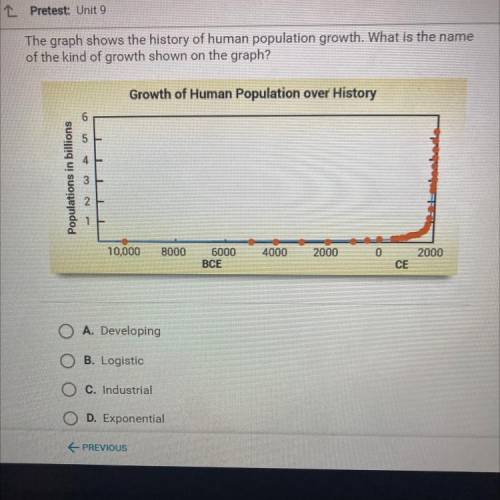
Biology, 15.05.2021 02:50 teescub812
The graph shows the history of human population growth. What is the name of the kind of growth shown on the graph?
A. Developing
B. Logistic
C. Industrial
D. Exponential


Answers: 1


Other questions on the subject: Biology

Biology, 22.06.2019 03:30, tpenn2476
Which set of characteristics best describes sedimentary rock? a) largest type of rock, made of organic matter, hardest type of rock b) often contains layers, forms near sources of water, contains fossils c) least abundant type of rock, made of other rocks, made mostly of minerals d) most abundant type in earth's crust, made of magma/lava, contains no fossils
Answers: 1

Biology, 22.06.2019 03:40, lashaunahard
20. in humans, freckles are dominant to no freckles. trey has no freckles and his wife anna grace has freckles, but her dad doesn't. they want to know what percentage of their kids would look like trey. show a punnett square to support your answer.
Answers: 1

Biology, 22.06.2019 04:40, 2016gbryant
Hurry where is the majority of earth's water found? o glaciers o oceans ground o rivers and lakes
Answers: 1

Biology, 22.06.2019 06:40, ethanmel21
The steps in the formation of extrusive igneous rocks are listed below in an incorrect order: 1. rock melts due to high temperature. 2. rock is buried deep under earth's surface. 3. magma is forced out of earth's surface during volcanic eruption. 4. lava cools and crystallizes to igneous rock. which of these best shows the correct order of steps in the formation of extrusive igneous rocks? 1, 3, 4, 2 2, 1, 3, 4 3, 4, 2, 1 4, 2, 1, 3
Answers: 3
You know the right answer?
The graph shows the history of human population growth. What is the name of the kind of growth shown...
Questions in other subjects:


English, 21.01.2021 01:00


Mathematics, 21.01.2021 01:00

Chemistry, 21.01.2021 01:00

Social Studies, 21.01.2021 01:00

English, 21.01.2021 01:00

Mathematics, 21.01.2021 01:00

History, 21.01.2021 01:00

Social Studies, 21.01.2021 01:00



